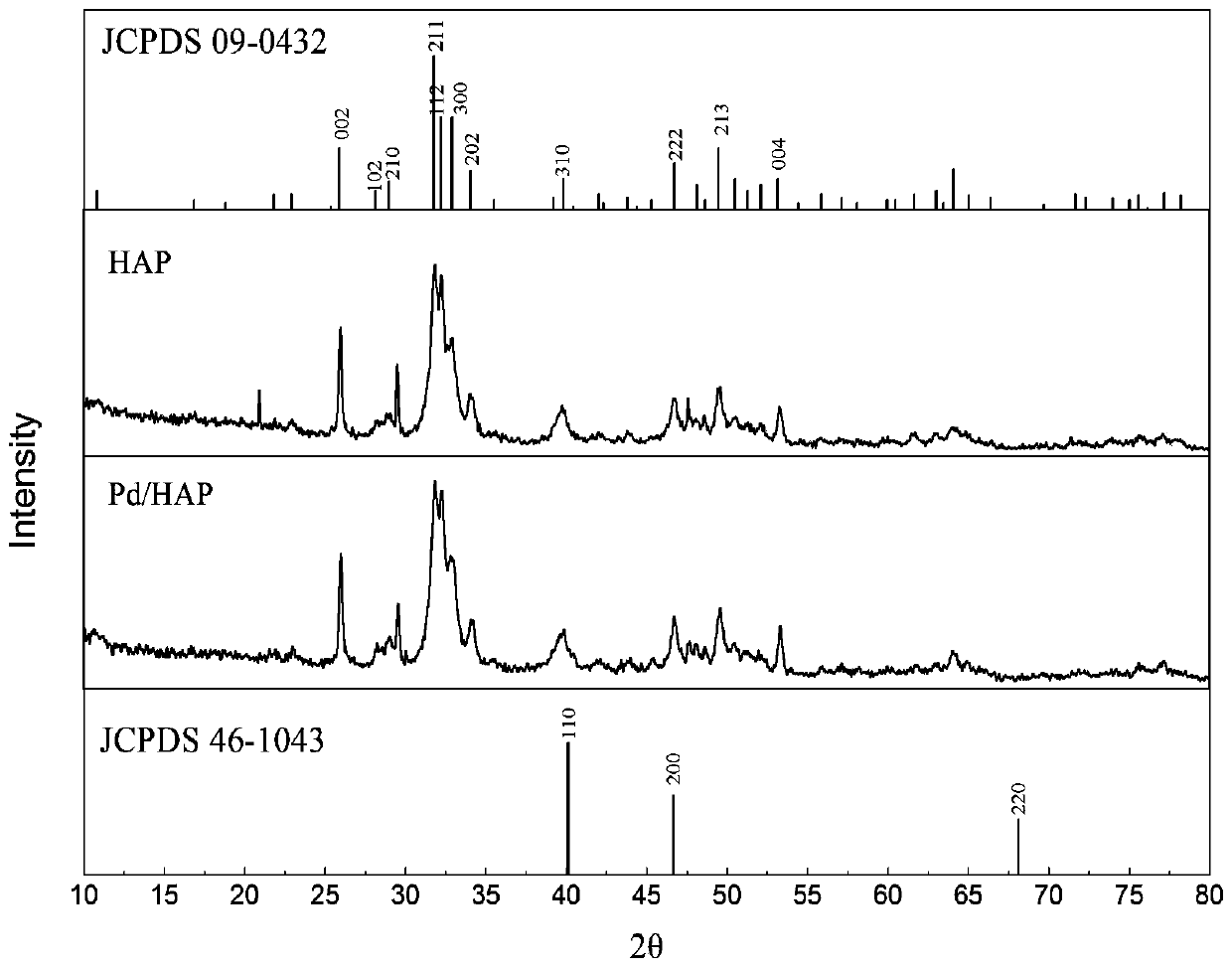Preparation and application of marine biological waste oyster shell-supported palladium catalyst
A technology of a palladium catalyst and an oyster shell is applied in the preparation of heterogeneous palladium catalysts and the field of preparation of marine biomass-supported palladium catalysts, and can solve the problems of environmental pollution, high price of homogeneous palladium catalysts, etc., and achieves a wide range of materials and simple processes. Effect
- Summary
- Abstract
- Description
- Claims
- Application Information
AI Technical Summary
Problems solved by technology
Method used
Image
Examples
Embodiment 1
[0047] Step 1: Preparation of nano-hydroxyapatite (HAP)
[0048] (1) Fresh oyster shells are cleaned and air-dried naturally, add an appropriate amount of 10% sodium hydroxide solution, and heat at 95°C for 5 hours to fully remove protein;
[0049] (2) Take out the oyster shell, rinse it repeatedly with water, dry it at 100°C, crush it, and pass it through a 100-mesh sieve; the obtained powder is dried at 70-100°C for 24 hours;
[0050] (3) Take oyster shells, (NH4)2HPO4, and cetyltrimethylammonium bromide and add them to the inner tank of the reactor (Ca / P molar ratio n(CaCO3):n((NH4)2HPO4) is 5:6) , adding an appropriate amount of deionized water, adjusting the pH to 6 with phosphoric acid, stirring magnetically at room temperature for 1 hour, sealing the reaction vessel, and stirring and reacting at 140°C for 24 hours;
[0051] (4) After the reaction kettle is cooled to room temperature, centrifuge to obtain a precipitate, and centrifuge and wash the precipitate with deion...
Embodiment 2
[0066] Step 1: Preparation of nano-hydroxyapatite (HAP)
[0067] (1) Fresh oyster shells are cleaned and air-dried naturally, soaked in 5% sodium hypochlorite solution for 1 day to remove protein;
[0068] (2) Take out the oyster shell, rinse it repeatedly with water, dry it at 100°C, crush it, and pass it through a 100-mesh sieve; the obtained powder is dried at 70-100°C for 24 hours;
[0069] (3) Add oyster shells, (NH4)2HPO4, and cetyltrimethylammonium bromide to the inner tank of the reactor (Ca / P molar ratio n(CaCO3):n((NH4)2HPO4) is 1:1) , adding an appropriate amount of deionized water, adjusting the pH to 6 with phosphoric acid, stirring magnetically at room temperature for 1 hour, sealing the reaction vessel, and stirring and reacting at 140°C for 24 hours;
[0070] (4) After the reaction kettle is cooled to room temperature, centrifuge to obtain a precipitate, and centrifuge and wash the precipitate with deionized water for 3 to 6 times until no carbonate ion is det...
Embodiment 3
[0084] Step 1: Preparation of nano-hydroxyapatite (HAP)
[0085] (1) Fresh oyster shells are cleaned and air-dried naturally, add an appropriate amount of 10% sodium hydroxide solution, and heat at 95°C for 5 hours to fully remove protein;
[0086] (2) Take out the oyster shell, rinse it repeatedly with water, dry it at 100°C, crush it, and pass it through a 100-mesh sieve; the obtained powder is dried at 70-100°C for 24 hours;
[0087](3) Take oyster shells, (NH4)2HPO4, and cetyltrimethylammonium bromide and add them to the inner tank of the reactor (Ca / P molar ratio n(CaCO3):n((NH4)2HPO4) is 5:6) , adding an appropriate amount of deionized water, adjusting the pH to 6 with phosphoric acid, stirring magnetically at room temperature for 1 hour, sealing the reaction vessel, and stirring and reacting at 140°C for 24 hours;
[0088] (4) After the reaction kettle is cooled to room temperature, centrifuge to obtain a precipitate, and centrifuge and wash the precipitate with deioni...
PUM
 Login to View More
Login to View More Abstract
Description
Claims
Application Information
 Login to View More
Login to View More - R&D
- Intellectual Property
- Life Sciences
- Materials
- Tech Scout
- Unparalleled Data Quality
- Higher Quality Content
- 60% Fewer Hallucinations
Browse by: Latest US Patents, China's latest patents, Technical Efficacy Thesaurus, Application Domain, Technology Topic, Popular Technical Reports.
© 2025 PatSnap. All rights reserved.Legal|Privacy policy|Modern Slavery Act Transparency Statement|Sitemap|About US| Contact US: help@patsnap.com



